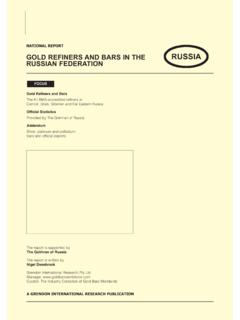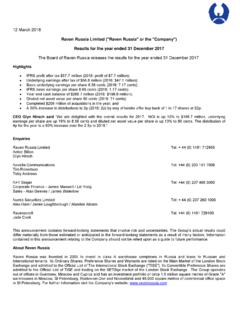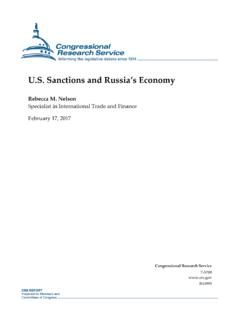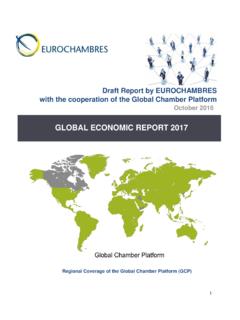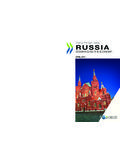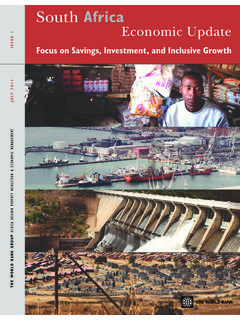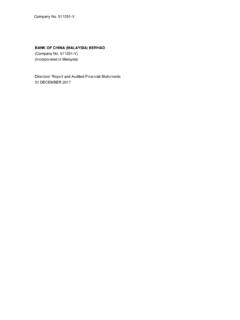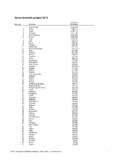Transcription of Overview of the Russian and CIS automotive industry
1 Overview of the Russian and CIS automotive industryFebruary 2017 ContentsForeword ..1 Executive summary and key considerations ..3 Russian economy ..4 Current state of the global automotive market ..6 russia in the context of the global automotive industry ..8 Passenger car and LCV market ..10 Truck market ..14 Bus market ..16 Localization and production of automotive components ..17 Dealership networks ..20 Car loan market ..22 CIS automotive markets ..24EY s services for the automotive industry ..27 Contacts ..28 ForewordThe Russian automotive industry is going through challenging times. The current macroeconomic situation has changed the auto market landscape and is holding back the recovery in auto sales. At the same time, the Russian market has high growth potential and in the next few years is expected to show signs of improvement, driven by stronger macroeconomic performance.
2 This report presents an analysis of the current state and future development of the Russian and CIS automotive industry . We believe it will successfully move away from stagnation to sustainable growth driven both by the commitment of most international players to develop business in russia and by government support for the industry . We would be glad to share with you our market expertise and assist you in meeting your business needs and identifying investment opportunities, and provide risk, operational and cost management advisory IvanovPartner, CIS Transaction Advisory Services LeaderAndrey TomyshevSenior Manager, Head of the CIS automotive Group2 | Executive summary and key findingsExecutive summary and key findingsKey findings: Despite a significant drop in car sales during the crisis, we remain positive about the long-term prospects for the Russian auto market due to the population s low level of vehicle ownership, the aging car fleet and major international players dedication to business development in russia .
3 In 2016, sales continued to decline along with real GDP, finally hitting the bottom. The share of domestic car brands continued to grow, with a decreasing share of imports. The market recovery may start in 2017, with passenger car sales growing to reach 2 million vehicles by 2020, and further growth to follow. The main drivers of growth will be the ruble exchange rate, oil prices, auto loans interest rates, the effectiveness of government support measures and the potential to reduce vehicle ownership costs. russia still has a lower auto loan penetration rate than the western countries. However, a gradual decrease in the CBR s key interest rate, the growing role of automakers captive banks and the overall recovery of consumer lending will ramp up the share of credit in car sales and boost growth in the automotive market.
4 The crisis has forced some dealers to exit the market or close dealership centers. This trend is largely explained by lowering margins due to weak business diversification and high levels of debt. It is also accompanied by industry consolidation and an increase in the market share of major players. To maintain their business for the long term, dealers need to transform the business model and better diversify their products and services, as well as invest in areas of the business such as the sale of used vehicles and financial products. The commercial vehicle market has been largely captured by Russian players, who increased their share during the crisis. The truck market is more sensitive to economic downturns than the passenger car fleet, although it can recover more quickly in the future. Our positive outlook for the Russian bus market is based on the considerable age of vehicles used for passenger transportation, as well as government support.
5 International OEMs continue to localize their production, although the process is being largely hindered by the lack of a high-quality pool of second-tier (and lower) suppliers. This can be addressed by targeted government support for Russian companies, consolidation of their production facilities, and cooperation with foreign players to gain access to advanced technologies. The secondary market for automotive components and spare parts has declined more slowly than the automotive market, backed by the growth of the vehicle fleet even during the crisis. The other CIS markets have declined due to a weaker macroeconomic environment and devaluation of the national currencies. Ukraine saw the highest volume of cars sold in 2016, while Uzbekistan remained the largest automotive producer. After a sharp rebound in 2010 11, the Russian automotive market slowed down in 2012 and has been facing a decline in sales since 2013 in the face of а weaker macroeconomic 2016, sales of passenger cars and light commercial vehicles (LCVs) totaled million forecasts suggest that the market may begin to recover in 2017, with passenger car sales growing to reach 2 million vehicles by 2020, and further growth to of the Russian and CIS automotive industry | 3 Key considerationsKey issuesManufacturers Suppliers Retail and distributionHow will demand for vehicles and mobility evolve?
6 Focus on vehicle ownership costs Take advantage of modern information technology and telematics Cooperate with market entrants and expand geographically Help build capabilities in the auto component industry Satisfy the demand for basic goods that meet automotive standards Take advantage of opportunities in the after-sales segment Align the car brand portfolio with the current macroeconomic environment and the trend toward localized production Be flexible with manufacturers and be capable of quickly switching from one car brand to another Encourage manufacturers to develop more offerings using modern information technology and telematicsHow will products need to adapt? Implement changes to meet the needs of end consumers and the conditions in which the vehicles are to be used Focus on the subcompact, premium and SUV segments Analyze factors that have the most potential, such as efficiency, emission reduction, fuel efficiency or safety technologies Develop low-cost products with consumer qualities required in a certain region Maintain a balance between selling vehicles and related service packages Develop and maintain communication mechanisms to retain customers loyaltyHow will business models need to adapt?
7 Enhance marketing activities to promote brand recognition Cooperate with new players in order to leverage their technology and experience Optimize the portfolio, expand into the CIS and non-CIS markets Incorporate sustainability into the core business strategy for long-term revenue growth Develop sales techniques and marketing strategy using social media and the Internet Diversify business to reduce the risk of a decline in consumer demand (trade in used cars, sale of used cars on a commission basis, sale of insurance policies, loans and other products) Analyze the cumulative profit margin over the vehicle s life-cycle as a tool for managing the business Expand through M&A What are the new market dynamics? Strengthen positioning of the manufacturers captive banks Actively develop and implement telematics solutions Form strategic alliances with car manufacturers to enhance cooperation at the advanced phase of the R&D process Consider a multi-brand retail and distribution strategy Develop new areas of business and new ways of winning customers, such as taxi services, automotive logistics and operating leasesWhat are the value chain issues and implications?
8 Monitor compliance with localization programs and requirements Monitor changes in tax and customs legislation Use enterprise management systems that enable transparency of cooperation across the supply chain Leverage special economic zones (SEZs) for new production facilities Develop the second-tier (and lower) supplier segment to ensure proper localization and establish a complete value chain Evaluate the distribution footprint and opportunities to expand into regions with high growth potential4 | Russian economyRussian economyIn 2015, russia s real GDP fell by under the pressure of economic restrictions and plunging oil prices. All sectors of the Russian economy were largely affected by external factors, as a result of which the industrial production index declined by and purchasing power dropped on the back of lower real disposable income.
9 The decline in Russian GDP slowed to in 2016 and an economic recovery is expected in economic indicators were largely affected by the restrictions, coupled with the sudden drop in oil prices. This severely weakened the Russian ruble and increased the cost of borrowing. On the positive side, the new economic reality made Russian assets more attractive to potential investors. In the coming years, foreign direct investment is expected to surge. russia s long-term investment attractiveness depends heavily on developing the legislative framework and reducing government involvement in the economy, as well as introducing new technologies in production and forecasts of nominal and real GDP growth in RussiaSources: MED, EIU, Oxford Economics, World Bank, CEEMEA, IMF, EY analysis, the Development Center of the Higher School of Economics*F , % 0 5% 4% 3% 2% 1%0%20112,02720122,16720132,22720142,027 20151,32720161,2272017F*1,4022018F*1,530 US$ billion5001,0001,5002,0002,500 Nominal GDPReal GDP growthOverview of the Russian and CIS automotive industry | 5 2011201220132014201520162017F*2018F*Popu lation, GDP growth, % per capita, US$14,177 15,016 15,53714,2769,279 8,853 10,294 11,140 Inflation, % Production Index, % crude oil price, US$ per rate among economically active population (annual average), % rate RUB/US$ (annual average) rate RUB/ (annual average).
10 BMI, MED, EIU, Oxford Economics EIA, Bloomberg, EY analysis, CEEMEA, the Development Center of the Higher School of Economics*F ForecastProjected key macroeconomic indicators6 | Current state of the global automotive marketCurrent state of the global automotive marketOver the past decade, sales of passenger cars and light commercial vehicles (LCVs) have grown by approximately 30%. In 2008 through 2013, this growth was largely driven by emerging markets, whereas today it is accelerated by Western Europe, China and India. In 2015, the global passenger car and LCV market grew by 2%, followed by a further increase in 2016 of 4% to reach million units, primarily due to increased sales in China ( ), India ( ), and Western Europe ( ). This growth was sparked by the drop in oil and fuel prices, economic revival in the West European markets after the Eurozone debt crisis, the continued urbanization and rising vehicle ownership rate in China (especially in small towns), and accelerated economic 2016, sales in the US remained flat, whereas in Eastern Europe and Latin America they dropped by and , respectively.










